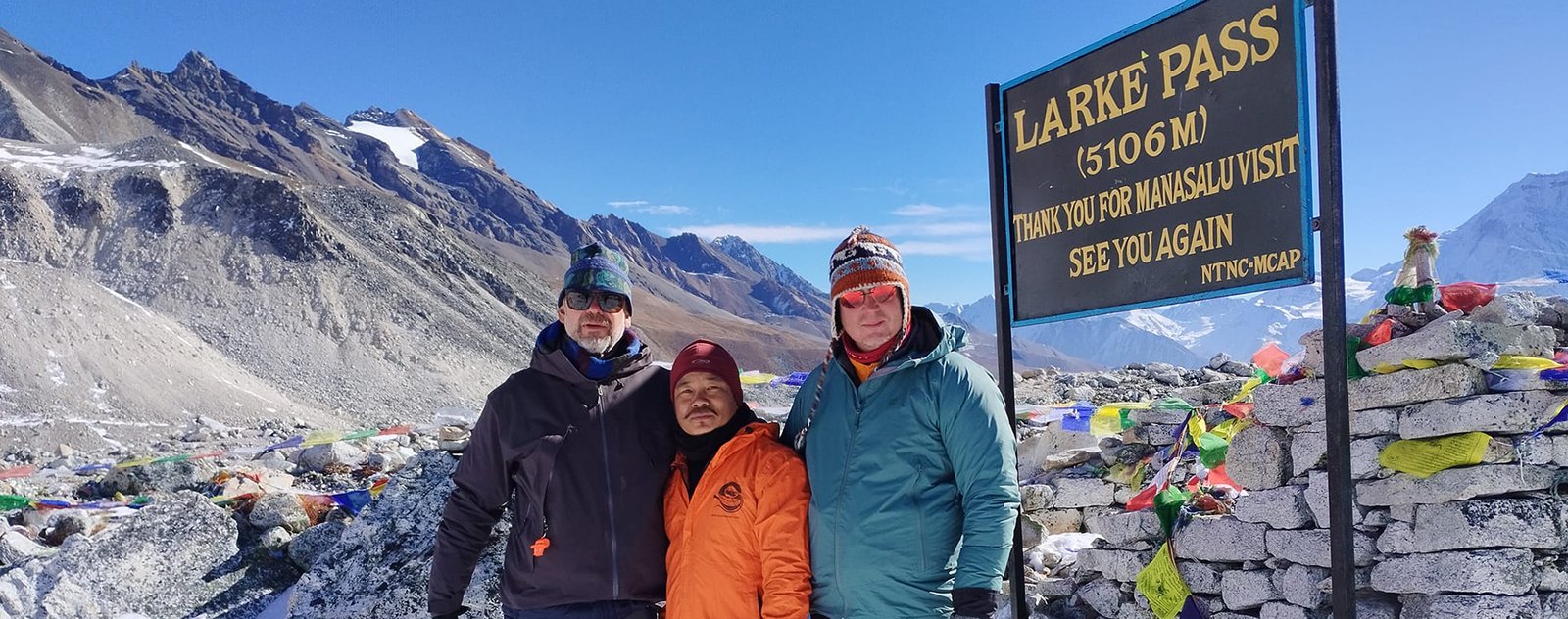
Manaslu Circuit Nepal– Walk on the wild side – Walk with Wollies The Manaslu Circuit trek is an ‘off the beaten track’ route, which takes you through remote landscapes, experiencing stunning views and Himalayan culture. But its difficult landscape and high altitudes can lead to some mistakes that are bound to alter your safety and pleasure. Knowing these traps in advance puts you in a better position to prepare and be successful on your trek.
I think one of the mistakes most trekkers make is that they do not realize the physical aspect of the Manaslu Circuit. To make matters worse, the journey requires days of high-altitude walking on rough trails and a crossing over the Larkya La Pass at over 5,100 meters. Lack of physical conditioning may result in tiredness, injuries, or failure to finish the trek comfortably. Begin seriously training early with an emphasis on cardio fitness and strength.
Failure to acclimate adequately is another typical mistake. This trek is also prone to altitude sickness, so climbing too quickly without allowing for rest days may result in headaches, nausea, or worse. Work in enough acclimatization days when planning your itinerary, especially around the takeoffs, like in Samagaon or Samdo. Pay attention to your body and do not power through symptoms.
Bad packing decisions also have an impact on your trek. Overpacking is just extra weight that’ll wear you down, though underpacking can leave you unprepared for cold nights or a surprise storm. You should have on layered clothing and have packed sturdy boots and important gear like water purification, a first aid kit, and a great sleeping bag.
Another mistake is ignoring the local environment and customs. The Manaslu region is replete with cultural heritage and environmental frailty. Demonstrate respect for nature by asking permission to photograph people, reducing waste, and staying on paths.
Logistics become trickier if you don’t hire a guide or porter. The Manaslu Circuit is less of a trodden path than well-trodden ones, which can make way-finding and permits a headache. Guides offer safety, cultural insight, and assistance in emergencies. Porters ease the burden, saving your energy for the challenge of the hike.
Finally, no travel insurance or emergency planning in place can be expensive. Make sure your insurance will reimburse you for high-altitude trekking, as well as for any emergency evacuation. Take a good means of communication and tell someone where you are going.
If you manage to avoid these six common errors — training too little, acclimating too poorly, packing too little, being too culturally insensitive, getting too little assistance, and being too uninsured — you’ll improve your odds of experiencing the Manaslu Circuit Trek in a safe, fun, and unforgettable way. Be prepared with an open mind for this remarkable Himalayan journey with respect for the environment and the culture.
Why Physical Preparation Is Critical For the Manaslu Circ Atithe the physical level, physical fitness is very critical in determining your success and safety during this trek. It involves long hours of walking and is characterized by rugged terrain, steep ascents, and high altitude, which can reach over 5000 meters at Larkya La Pass. Unprepared trekkers run the risk of exhausting themselves before reaching their daily destinations, injuries, or inability to finish the trek in its entirety. Cardiovascular fitness acquired through running, cycling, and swimming increases stamina, which helps you to walk for many days in a row. Strength training of legs, core, and back also increases the muscle power required in walking through rough terrain with a backpack on the back. Hiking on uneven surfaces with some weight on your back will allow you to simulate the real trekking environment. Poor fitness levels can cause slow recovery, low stamina, which can make your experience less enjoyable. It also boosts confidence and morale, which are very crucial when tackling challenges associated with harsh weather and rugged terrain. A few months of prior planning of your fitness regimen will ensure you have a safe, enjoyable Manaslu trek. 2. Proper acclimatization Proper acclimatization is the most important factor for achieving success on the Manaslu trek. Trekking is done at high altitudes, and some points are as high as 5000 meters above sea level. Such treks are characterized by decreased levels of oxygen, meaning that no one can keep ascending for so long without acclimatizing. Failure to acclimatize can lead to Acute Mountain Sickness that comes with migraines, dizziness, and in worst circumstances, can be fatal. Our itinerary includes several days in Samagan and Sam, which is vital for your body to acclimatize. You are warned against ascending too high, too fast. You must also listen to your body. When your sufferings escalate after some rest, it is time to descend.
Remaining hydrated and having a proper diet also promote acclimatization. Some trekkers also take medication like acetazolamide (Diamox) after consulting a doctor, which can alleviate symptoms.
Successful acclimatization means a safer, stronger, more enjoyable trek, impacting both your endurance and your appreciation for the stunning environment over the course. By scheduling with flexibility in mind, you not only allow yourself to take the time you need but also to change your pace as required.
Packing Tips To Avoid the Most Common Trekking Snags
The better you pack for your Manaslu circuit trek, the more pleasant and problem-free your trip will be. If you over-pack, then you add unnecessary weight and fatigue to your hike, and if you under-pack, then you may not be ready for cold or wet conditions.
Manaslu Circuit Adaptation to temperature extremes is made easy by the altitude changes— hot temperatures in the valleys with chilly passes over 17,000ft. Requires layered clothing. Layer moisture-wicking base layers under insulating mid-layers, and pack a waterproof outer shell. Sturdy hiking boots with ankle support prevent injuries on rugged surfaces.
Make sure to bring an excellent sleeping bag for cold nights, particularly near Larkya La Pass. Trekking poles can take a lot of the strain off your knees while ascending and descending steep climbs. You should take essentials such as a waterproof sunscreen, headlamp, first-aid kit, water-sterilization equipment, and high-energy snacks.
A well-packed backpack is one that accomplishes the blend of prepared, but not laden, where energy is conserved (rather than expended) on the trail. 10) Don’t overpack with electronics and valuables. And do pack a good camera to record stunning vistas and cultural moments.
Planning thoughtfully will make sure you finally avoid any discomfort, injury, embarrassment, or other last-minute troubles to make your Manaslu adventure smoother and an enjoyable one.
No Hassle with Permits and Law Applications
It is important to know and secure all required permits before embarking on the Manaslu Circuit Trek. The trail goes through controlled and conservation areas, which necessarily need a number of government permits for legal reasons and also in order to protect the region’s delicate ecosystem.
Is the Manaslu trek open now? You also need a Manaslu Restricted Area Permit along with the Annapurna Conservation Area Permit (ACAP). Furthermore, a Trekkers’ Information Management System (TIMS) card is needed for the safety and registration of trekkers.
Manaslu Base Camp Trek Permits are obtained in Kathmandu, Pokhara, or through trekking agencies that will process the paperwork for you. Manaslu is a restricted Region and has a daily limit on permit numbers, so it is recommended to apply in time to avoid any delays.
Do not forget to take your permits with you when you are going for the trek, as checks are done at checkpoints. If you don’t have the proper permits, you can be fined or prevented from continuing.
Careful planning of this angle avoids unnecessary troubles and helps towards preservation, with an amenability towards local authorities.
The Contribution of Guides and Porters to Safety
Local guide and porter for Manaslu Circuit Trek Hiring a local guide and porter for Manaslu Circuit Trek drastically enhances the safety level, self-confidence, and cultural integration during a trip. The remote nature of the trek, in comparison with better-known routes like Everest Base Camp, results in the trails being less developed and with far less signage.
Guides are skilled at negotiating difficult terrain, speaking with locals, and keeping watch over your health, particularly signs of altitude sickness. Their familiarity with the environment and culture enhances your experience, offering you insights you’d otherwise be unable to appreciate.
Porters carry heavy suitcases, and you have less physical effort to do on the trek. An overall lighter backpack also lessens fatigue and reduces the chances of injury, something that is very important on a challenging trek.
Hiring local employees also bolsters the economy in the area, helping local communities along the trail. You could certainly give the route a shot without a guide if you’re a well-travelled trekker, but most trekkers appreciate the confidence and safety afforded by hiring a professional.
Selecting licensed, reliable guides and porters constitutes responsible tourism, and the key to a better and more enjoyable Manaslu experience.
How to Respect Local Culture and Tradition on the Trail
Climb Manaslu From experience, showing cultural respect, whether hiking the Manaslu Circuit Trek, helps improve your experience and with the local communities. Ethnic groups living in this region include Gurung, Tibetan, and Sherpa, who have their own distinct traditions, languages, and cultures.
Always get permission to take photos of people and religious sights, like monasteries and stupas. Respectful curiosity is appreciated by many locals, but invasive behavior isn’t. Dress conservatively and don’t be unnecessarily noisy, particularly in villages and religious sites.
Joining in local fetes or festivals, if your trek falls close to one. Champion a few greetings in local languages, and you can feel warmth and connection. Support local businesses by buying handicrafts or eating at teahouses personally owned by locals.
Leave as little impact as possible by not littering, limiting the amount of plastics you bring with you (or better yet, avoid it altogether), and sticking to the existing trails. Respect rules regarding sanctified sites, as many are spiritually important and guarded.
Demonstrating respect allows locals to sustain their culture and ensures that tourism enriches rather than upends local life. A down-to-earth, open-minded attitude fosters rich cultural exchange and a deeper trekking experience.
Prevention of Altitude Illnesses: Practical Tips
There is a serious risk of altitude sickness in the Manaslu Circuit Trek because it goes to elevations of over 5000 meters. Avoiding it is a matter of planning and vigilance.
Climb slowly to help your body adjust to the decrease in oxygen. The programme rests for days at a middle altitude in Samagaon and Samdo. Once beyond 3,000 meters, do not ascend more than 300-500 meters per day.
Stay well-hydrated with sips of fluid, but take care not to drink too much caffeine or alcohol, as both can dehydrate you. To fuel your body and to assist in acclimatization, eat high-carbohydrate meals.
Know symptoms like headache, dizziness, nausea, and fatigue. If you get worse, stop going up or go down at once. Discuss taking some medication, such as acetazolamide (Diamox). With your doctor.
Oxygen saturation can be monitored with a pulse oximeter, but it should not substitute for monitoring of physical symptoms. Be honest about how you feel with your guide or trekking partners.
There is, however, no substitute for adequate acclimatization and listening to the signals that one’s body gives, as this will offer the best protection against altitude sickness, make the trek more enjoyable, and safer.
When is the Best Time of Year for Your Manaslu Trek?
Manaslu Circuit Trekking Choosing the right season for your Manaslu Circuit Trek is critical for good weather and trail conditions. The optimum trekking seasons are pre-monsoon (March-May) and post-monsoon (September-November).
The weather is normally good at these times, and the temperature is moderate, making for beautiful vistas of the Manaslu (8163m) and other neighboring peaks. Rhododendrons burst into flower in the spring, and fall brings clear skies.
Avoid the monsoon season (June-August), as heavy rainfall makes for slippery tracks, landslides , and limited visibility. For winter (Dec–Feb), expect extreme cold, snow on high passes, and many teahouses to be closed.
The high trekking seasons are so popular that you should book early, as the number of permits and lodges along the track is limited. Flexibility is imperative with any itinerary adjustment for inevitable weather changes, and make sure you have some spare days, as Larkya La Pass becomes unpredictable in the mountains.
Pick the best season to best ensure safety, comfort, and the best natural scenery of the Manaslu Circuit Trek!
Dealing with Weather and Trail Conditions
Manaslu Circuit Weather The weather on the Manaslu Circuit can be quite unpredictable, with little downtime. There can be quick changes that present difficulties for hikers. Paying attention to local climate and reacting properly can prevent the traps that local weather lays all the time.
Be prepared for cold mornings and evenings at altitudes above 3,500 meters. Wind or waterproof protective clothing is important in the monsoon and sudden rainstorms. The advantage to layers, rather than the one-piece fit, is your ability to add on or peel away depending on the ever-changing temperatures.
Path conditions range from good to rough sections, narrow scrabbling over rocks, and river hopping. If possible, use trekking poles to help balance and take pressure off your knees. Take care when moving on slippery or unstable terrain to avoid slips and falls.
Stay informed on weather predictions and follow local guides’ recommendations. If severe weather hits, it’s safer to take cover in a village than get caught in dangerous conditions.
With the right equipment, sensible pacing, and sensitivity to the environment, you can cope with the challenges of weather and trails and reach your destination, enjoying a safe and satisfying trip.
Preparing for the Worst: Insurance and Communication
Manaslu Trekking Preparing for the Manaslu Circuit. The first problem for any hike in Nepal is the emergency plan. The medical infrastructure along the way is sparse, and the remote terrain can complicate evacuations.
Buy travel insurance that includes high-altitude trekking and emergency helicopter evacuation. Make sure your policy covers treatment for altitude sickness and injuries.
Bring a dependable means of communication, i.e., satellite phone, or a local SIM card for mobile phone coverage if applicable. Let family and friends know where you’re going, and check in periodically.
Take a good first aid class and bring a respectable first aid kit with altitude sickness medication, pain relief, and wound care items.
Arrange for emergency numbers in Kathmandu or the trek. If you fall seriously ill or are injured, descend or call for evacuation.
Peace of mind in case of emergencies, giving you the ability to relax and enjoy your Manaslu Circuit adventure.
How to get ready for the Manaslu Circuit trek?
Training and Equipment for the Manaslu Circuit Trek Getting ready for the Manaslu Circuit Trek involves physical prep, research, and getting the right gear. Because the hike is over challenging terrain and at high altitude, concentrate on cardiovascular and leg strength activities such as hiking, running, cycling, or climbing stairs. Hiking with a loaded pack is the best way to simulate trekking conditions and get your body used to long days on the trail.
Acclimatization is the key, so build in rest days in beautiful places like Samagaon and Samdo. Read up on the weather patterns and pack clothes you can layer for cold nights and unpredictable mountain weather. Bring necessary equipment such as durable hiking boots, a good sleeping bag, water purification equipment, and a first aid kit.
Be informed on requirements like the Manaslu Restricted Area Permit and the Annapurna Conservation Area Permit (ACAP). You might want to hire a local guide and a porter to show you the permits and trails. Finally, organise travel insurance for high-altitude trekking and emergency evacuation.
Prepare well and take on the Manaslu Circuit Trek safely to enjoy its beautiful landscapes and rich culture.
Is it Safe to Trek the Manaslu Circuit?
Manaslu Peak Circuit Trek is a safe-off beaten trek, fairly safe with due preparation and alertness. The trail is less traveled and more remote than better-known treks, so facilities and medical resources are sparse. The biggest danger now is altitude sickness at over 5,000m.
It is only safe if climbers acclimate gradually, are in excellent physical condition, and bring appropriate equipment. Experienced local guides would also be hired, both to help keep skiers safer by knowing the routes and culture, and to provide employment. Weather can shift suddenly, and bringing proper gear for cold, rain, and snow is critical.
You can be evacuated, but it’s expensive, so good travel insurance is essential. Don’t force your schedule and listen to what your body’s telling you. COURTESY OF MARD/OTHER By taking the Manaslu Circuit trek seriously and planning well, you will experience a safe and rewarding Himalayan adventure.
How Hard is the Manaslu Circuit Trek?
As far as difficulty, the Manaslu Circuit Trek is either moderate to hard for its length, altitude, and terrain. Trekkers spend long days on foot, along rough, rooty pathways, and they’ll be crossing the challenging Larkya La Pass at 5,160 meters. Fitness and stamina are a necessity due to the level of exertion and high altitudes.
Weather and trail conditions can also differ — cold temperatures and rain,n and occasional snow make it more challenging. The trek’s remote location also results in fewer amenities and longer waits for help in emergencies.
Though the more experienced trekkers find the difficulty level rewarding, beginners are required to train hard for it or hire porters and guides. But with the right kind of physical preparation, acclimatization, and mental preparedness, the level of difficulty is manageable, and you can truly appreciate the stunning scenery and wonderful cultural experience of the trek.
Do I Need a Guide for the Manaslu Circuit Trek?
Manaslu Mountain It is highly recommended but not a legal requirement for all trekkers to employ a guide for the Manaslu Circuit Trek. Then myo The path is less established and sign-posted than the more popular treks, which makes it difficult for first-time trekkers.
Guides have local knowledge, help obtain permits, offer cultural insights, and monitor your health, for altitude sickness in particular. They also assist in communicating with the locals and in making arrangements for lodging.
A guide makes the area safer and your experience more rewarding in general, here in this remote and constrained space. Many trekkers also employ porters to carry the heavy load of their backpacks, taking the load off their backs.
Experienced trekkers with a good sense of direction may choose to trek on their own, but for most people, hiring a guide is not just a good idea, it’s also beneficial to the local economy.









